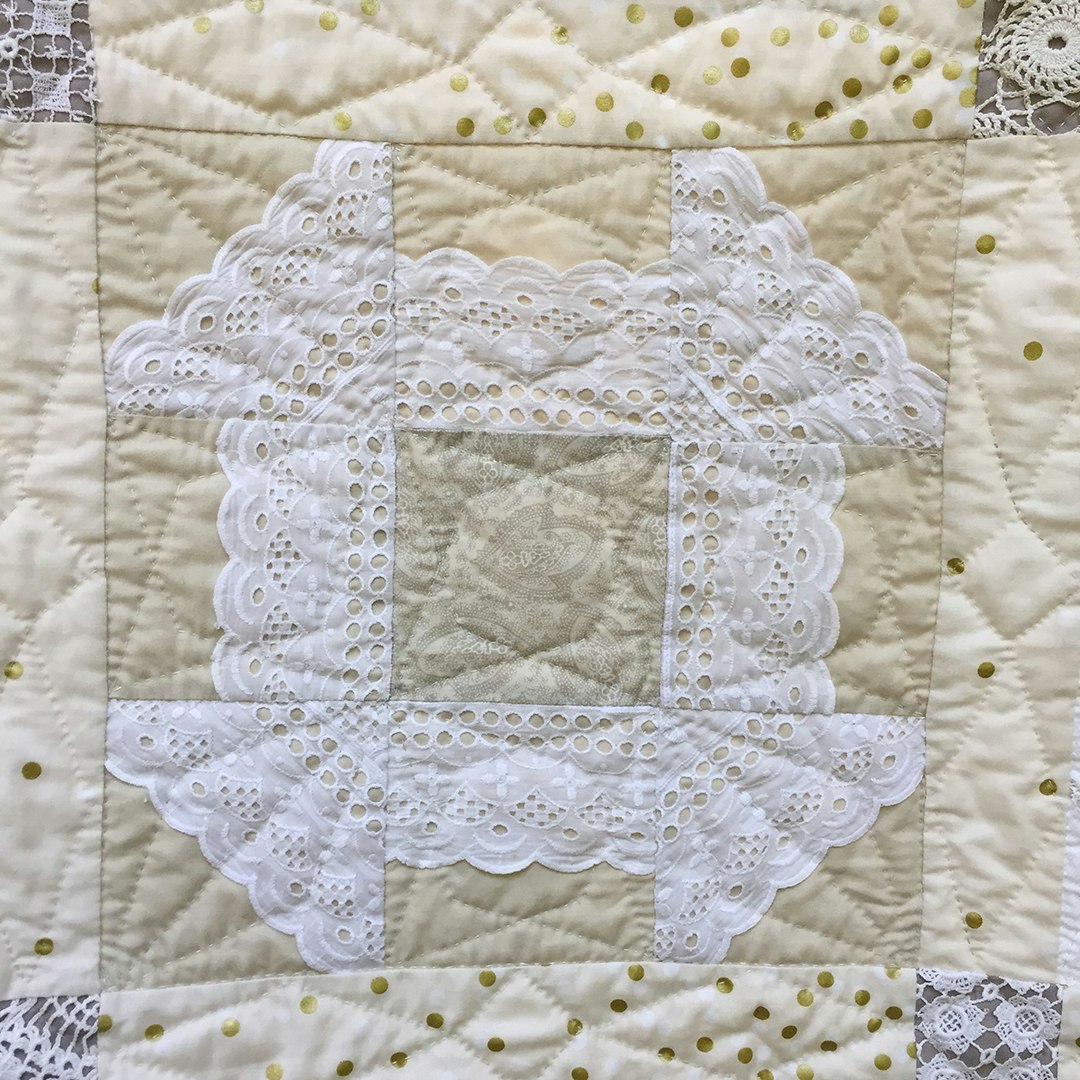My grandmother decorated her house with doilies. She used them under lamps, as antimacassars, on my grandfather’s smoking stand, and an especially large one crowned the mahogany dining table topped with a vase of flowers from her garden. They were filigrees of function and beauty crocheted by the women in my family. After my grandmother passed away, I rescued the doilies from the donate pile, appreciating the handiwork, yet aware that they were relics of a bygone era.
 Use quilt blocks that highlight your vintage linens. The lace edging in this block was given to Christine as a bridal-shower gift by an aunt. The gift consisted of a length of unfinished tatted trim about 40 inches long with a spool of thread attached. Christine's aunt instructed her to finish the trim and use it to embellish a pillowcases, but Christine thinks that her aunt would be pleased to see it in this quilt.
Use quilt blocks that highlight your vintage linens. The lace edging in this block was given to Christine as a bridal-shower gift by an aunt. The gift consisted of a length of unfinished tatted trim about 40 inches long with a spool of thread attached. Christine's aunt instructed her to finish the trim and use it to embellish a pillowcases, but Christine thinks that her aunt would be pleased to see it in this quilt.
Decades later, I unearthed the doilies from the back of a linen closet. I offered them to my daughters, who politely declined; it turns out twenty-somethings do not decorate with doilies either. I considered donating or selling them, or simply returning them to the closet for my daughters to sort out when the time came. Though doilies are obsolete in terms of practical use, the time-honored skill and craftsmanship of the women who made them was something I still felt compelled to preserve. After much deliberation, I decided to preserve the work of my ancestors in a quilt.
 For this variation on the Churn Dash block, Christine used the edges of a large doily. Including vintage doiles and linens in your blocks gives the quilts texture and creates visual interest.
For this variation on the Churn Dash block, Christine used the edges of a large doily. Including vintage doiles and linens in your blocks gives the quilts texture and creates visual interest.
The following is a list of tips and techniques I learned in the process of upscaling my grandmother’s vintage linens into a quilt.
- Be fearless. Have an idea? Try it and see how it works out.
- Any vintage linen will work—tea towels, tablecloths, handkerchiefs, dresser scarves, the lace edging off a women’s slip, to name a few.
- Fussy cut the pieces for symmetry, size, shape, and spacing. Watch directionality of doilies and plan ahead before cutting. Make sure you can get the right number, size, and position of pieces. This is especially true for round doilies.
- Quick block-making techniques (for example, quarter-square triangle units) may not work. Hand cutting each piece may be required.
- Work around tears and stains in your linens (or not). Handstitch frayed, torn, and loose edges to the background fabric to anchor in place.
- Press linens well before cutting, using a good spray starch (I used Mary Ellen’s Best Press).
- Start with easy blocks (Churn Dash is a good first block) to get a feel for how the textiles will look in a given block. All blocks should be the same size. I used 12-inch blocks. There are many sources for free quilt-block patterns on the internet.
- Press seams away from doilies when possible.
- Hand baste your vintage linens to your lining fabric to stabilize—especially for fragile linens.
- Quilt by hand so raised edges do not get snagged under the machine needle. This also continues the heritage of handwork. I quilted clean straight lines and geometric motifs from the Art Deco period of 1920s and 1930s, which matched the era in which the doilies were made.
- Handle fragile linens with kindness.
 For this variation on the Churn Dash block, Christine used sections of a dresser scarf. She suggests going with what looks pleasing to your eye.
For this variation on the Churn Dash block, Christine used sections of a dresser scarf. She suggests going with what looks pleasing to your eye.
In the end, I honored and breathed new life into the handiwork of the women who came before me. I signed the back of the quilt, which is a gift for my daughter, with a quote from Lalah Delia, “Your grandmother’s prayers are still protecting you.” I think my grandmother would approve.
Christine Weisenburger comes from a family of needle artists and craftswomen. She enjoys, quilting, sewing, needlepoint, and embroidery.
Originally published June 7, 2021; updated January 4, 2023.

